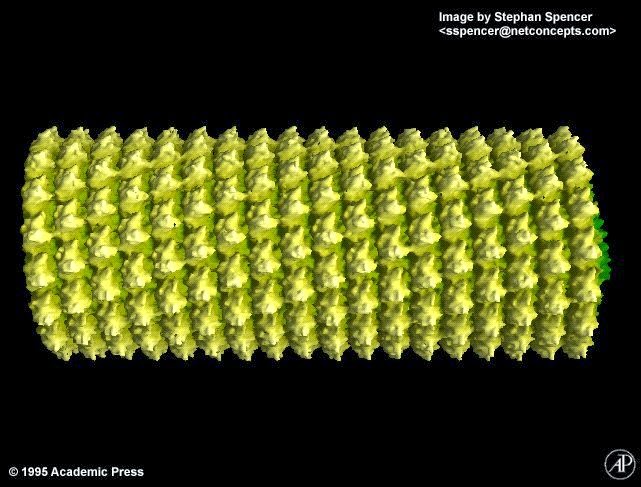 On the right, is an example of a densely packed pomegranate with the casing removed. When looking through some of the original bacteriophage literature, it seems that the maximum occupancy of the host by phage particles is approximately 25%. Which is not surprising since the host has other things it needs to accommodate even when it is invaded.
On the right, is an example of a densely packed pomegranate with the casing removed. When looking through some of the original bacteriophage literature, it seems that the maximum occupancy of the host by phage particles is approximately 25%. Which is not surprising since the host has other things it needs to accommodate even when it is invaded. |
| Rabies |
 |
| Maize |
 |
| TMV showing the helical arrangement of subunits |
 In contrast, the helical pitch of the subunits that form the outer casing of Tobacco Mosaic Virus illustrates that assembly pathways can influence the arrangement of subunits in a way that is distinct from the maize arrangement of its kernels. It is clear that evolution has settled (as usual) on several ways of packaging material either for protection (as in the viral capsid and nucleic acids) or for access (in the case of maize). Moreover, in contemplating assembly, the TMV arrangement has more in common with a certain Swedish domestic furnishing organisation, than a classical sculptor! Although the occurrence of natural helical growth is observed in some climbing plants (above right)?
In contrast, the helical pitch of the subunits that form the outer casing of Tobacco Mosaic Virus illustrates that assembly pathways can influence the arrangement of subunits in a way that is distinct from the maize arrangement of its kernels. It is clear that evolution has settled (as usual) on several ways of packaging material either for protection (as in the viral capsid and nucleic acids) or for access (in the case of maize). Moreover, in contemplating assembly, the TMV arrangement has more in common with a certain Swedish domestic furnishing organisation, than a classical sculptor! Although the occurrence of natural helical growth is observed in some climbing plants (above right)? Those of you over 50, or interested in space exploration, will recall the LEM (Lunar Excursion Module) which was delivered to the moon in 1969 via Apollo 11. For many of us currently active in Science, this was surely a landmark event. The general features of the LEM are strikingly similar to those observed through many elegant Electron Microscopy studies of Bacteriophage T4, and more recently through the superb crystallographic work of Professor Michael Rossman's group at Purdue University. I think the comparisons speak for themselves!
Those of you over 50, or interested in space exploration, will recall the LEM (Lunar Excursion Module) which was delivered to the moon in 1969 via Apollo 11. For many of us currently active in Science, this was surely a landmark event. The general features of the LEM are strikingly similar to those observed through many elegant Electron Microscopy studies of Bacteriophage T4, and more recently through the superb crystallographic work of Professor Michael Rossman's group at Purdue University. I think the comparisons speak for themselves!Finally, the organelles that drive energy production and harnessing in Biology are the mitochondria and the chloroplast. These structures tend to be less packed internally than say the pomegranate model above. Instead, they are characterised by invaginations of membranes, which form the scaffold and medium for electron transfer proteins. I'll let you be the judge of my Passiflora edulis analogy?


No comments:
Post a Comment